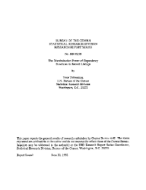The Discrimination Power of Dependency Structures in Record Linkage
The Discrimination Power of Dependency Structures in Record Linkage
Abstract
A record-linkage process brings together records from two files into pairs of two records, one from each file, for the purpose of comparison. Each record represents an individual. The status of the pair is a “matched pair” status if the two records in the pair represent the same individual. The status is an “unmatched pair” status if the two records do not represent the same individual. The record-linkage process is governed by an underlying probabilistic process. A record-linkage rule infers the status of each pair of records based on the value of the comparison. The pair is declared a “link” if the inferred status is that of a matched pair, and it is declared a “non-link” if the inferred status is that of an unmatched pair. The discrimination power of a record-linkage rule is the capacity of the rule to designate a maximum number of matched pairs as links, while keeping the rate of unmatched pairs designated as links to a minimum. In general, to construct a discriminatory record-linkage rule, some assumptions must be made on the structure of the underlying probabilistic process. In most of the existing literature, it is assumed that the underlying probabilistic process is an instance of the conditional independence latent class model. However, in many situations, this assumption is false. In fact, many underlying probabilistic processes do not exhibit key properties associated with conditional independence latent class models. The paper introduces more general models. In particular, latent class models with dependencies are studied and it is shown how they can improve the discrimination power of particular record-linkage rules.
Others in Series
Working Paper
Working Paper
Working Paper




